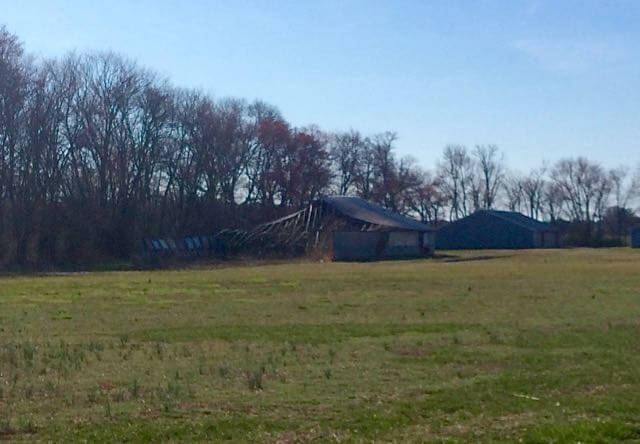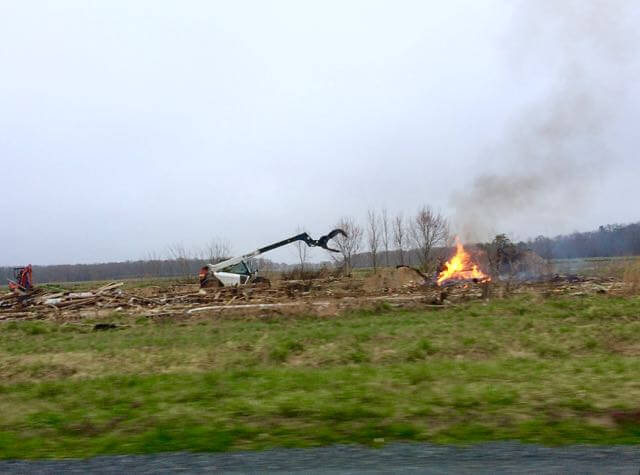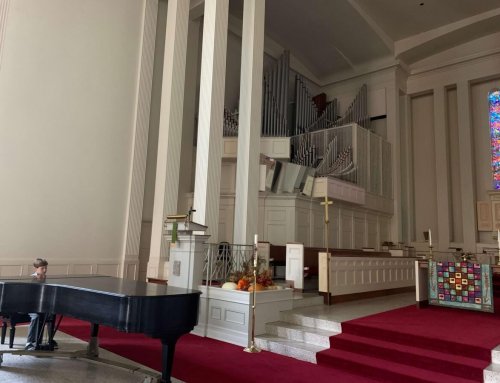
This chicken house was converted to a barn and then, eventually fell. There was one next to it, but it was burned a few years ago.
You don’t have to go far to find all the different chicken house styles that have used on the Delmarva peninsula. Within a 20 mile radius (and with a little digging) you will see everything from the deluxe chicken hotels to back yard models that range from trashy to gaudy. In case you’re not familiar, chicken hotels are two- or three-story structures that stand out on the horizon like the Neanderthals they are, evolutionary offshoots that either have fallen out of favor or practicality. I don’t know which. They seem tailor-made for the Eastern Shore, so the fact that there are no chicken skyscrapers suggests they were impractical.
Most of the chicken houses I see under construction today look like what I’ll call “traditional” chicken houses, which are distinguished in size and purpose from the backyard variety of chicken coop. Chicken houses are long narrow buildings sheltering more than 1,000 birds (according to a cursory Internet search). Look inside any elongated stand of trees along oddly shaped back road plots, and you are likely to find structures that have become part of nature’s chicken house reclamation project. There must be a different reason attached to each of the chicken houses overrun by trees, but I want a narrative, mostly because I’m driving idly and want to think about first causes related to how a chicken house gets abandoned.
When I stumble across a hidden chicken house it is on a piece of property that appears to have been part of a larger collection. I imagine the landowners either put up one house and gave up (lots of people lose chickens to disease, foxes, weather, etc.) or that they are a remnant from a more bountiful time, when the farmer kept just the one house to support his farm during lean times.
Other dilapidated chicken houses tell a completely different story. Grouped together in larger numbers, they appear to be relics of a more recent time. Victims of a 20th or even 21st century downturn. Temporarily abandoned, often for sale, sometimes these places have second lives as storage sometimes serving additional years as an equipment barn. Usually though they, like the chickens raised within were born for the fire. Chicken-raising technology has taken leaps and bounds in the last decade, and people at the raising end do a better job than ever before at keeping the chickens in good health until they’re spirited away on the dusty dirty trucks that always seem to be in front of me on two lane highways. As a result, (of the technology, not of the moving roadblock) new chicken houses are replacing the old as a matter of course. The old ones traditionally are burned to the ground.
There used to be a civil process for torching chicken houses. I guess there still is, but it varies depending upon the state and county. My 20-mile route to work takes me through two states, three counties and several incorporated towns. I have seen a lot of chicken houses on fire. Sometimes when they go, it is part of the fire training referred to as a controlled burn. The first responders seem to have a certain amount of glee for which I cannot blame them. Burning a chicken house to ground is probably among the safest ways to play arsonist and firefighter in the same evening.
More often, though, the houses are bulldozed, collected into piles and burned. Joy-inducing as a live controlled burn is, there is a combination of fire department liability, state, local or county bureaucracy that makes it more trouble than it is worth. Add to that the space between when the owner wants it burned, the weather, season and other factors and it is easy to see why there are more than a few do-it-yourselfers setting these fires.

The chicken houses were rubble in the morning. They were most of the way burned down by the time I was on my way home from work.
Until the week before the property owner arranged for the chicken houses to be bulldozed and burned, I was pretty sure the chicken houses along Bethel Road were destined to be reclaimed. I’ve been passing them each day, on and off, for the better part of a decade, but hadn’t really thought about them being taken back by nature until relatively recently, when nature’s play for the houses became obvious.
My guess is that the landowner noticed as well. And where I saw potential, a future where I could remember watching the field swallow the chicken house whole over the course of another few decades, he saw a haven for snakes, foxes and lord-knows-what-else fewer than 50 feet from the frontage homes on either side. Just up the road, massive new chicken houses are will under construction. They seem to be as much constructed of steel as of wood, and while they’re not as sturdy as the first houses, built just about 100 years ago in the region, they have a permanence to them that’s always has been missing from the previous generations of mega-coops.
Although, I guess, it is the rare chicken house that is built temporarily. Those that have been reduced to rubble and then to ashes were built to be as permanent as the ones abandoned to the arc of nature and time. But, then again, no one buys land with the intention of losing it to the bank or selling it off over generations to people whose interests aren’t yours. The chicken houses kind of remind me that while no one sets out to fail at raising chickens in the heart of chicken country, many still are able to find a way.






Leave A Comment